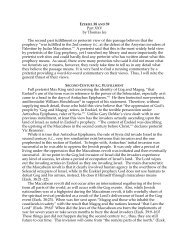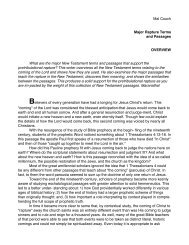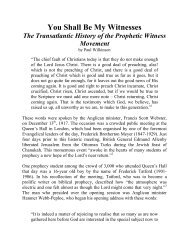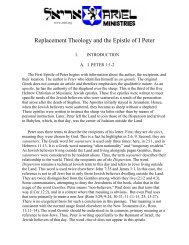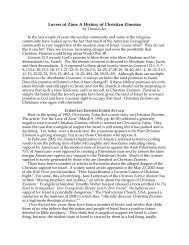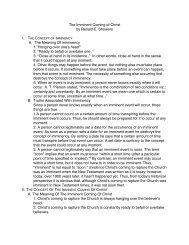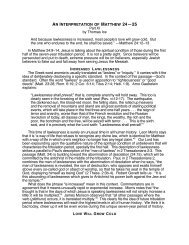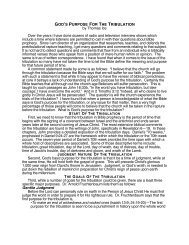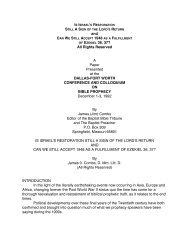DISPENSATIONAL HERMENEUTICS - Pre-Trib Research Center
DISPENSATIONAL HERMENEUTICS - Pre-Trib Research Center
DISPENSATIONAL HERMENEUTICS - Pre-Trib Research Center
Create successful ePaper yourself
Turn your PDF publications into a flip-book with our unique Google optimized e-Paper software.
<strong>DISPENSATIONAL</strong> <strong>HERMENEUTICS</strong><br />
Thomas D. Ice<br />
“Consistently literal or plain interpretation is indicative of a dispensational approach<br />
to the interpretation of the Scriptures,” declared Charles Ryrie in 1965. “And it is this<br />
very consistency—the strength of dispensational interpretation—that irks the<br />
nondispensationalist and becomes the object of his ridicule.” 1 “Consistently literal<br />
interpretation" was listed by Ryrie as the second most important sine qua non of<br />
dispensationalism, which forms the foundation for the most important essential, "the<br />
distinction between Israel and the Church." 2 Earl Radmacher, in 1979, went so far as to<br />
say that literal interpretation "is the 'bottom-line' of dispensationalism." 3 While the<br />
ridicule of nondispensationalists has continued, there also appear to be signs of<br />
hermeneutical equivocation within the ranks of dispensationalism.<br />
Within contemporary dispensationalism, some are moving away from the generally<br />
held hermeneutical statements of Ryrie and Radmacher. Craig Blaising concluded “that<br />
consistently literal exegesis is inadequate to describe the essential distinctive of<br />
dispensationalism. Development is taking place on how to characterize a proper<br />
hermeneutic for dispensationalists.” 4 Blaising and his coauthor Darrell Bock assert that<br />
the grammatical-historical hermeneutic “is shared broadly in evangelicalism, so<br />
consequently present-day dispensationalists do not think of themselves as having an<br />
exclusive hermeneutic.” 5<br />
Outside dispensational circles some would admit that dispensational hermeneutics<br />
“continues to exercise a widespread influence among evangelical Christians today.” 6<br />
However, many do continue to see the literal approach as an object of ridicule. Most<br />
likely, the loudest voice of dissent against the consistent literal hermeneutic of<br />
dispensationalism is from Christian Reconstructionists. Kenneth Gentry labels the<br />
dispensational claim to consistently literal interpretation as a “presumption” that “is<br />
unreasonable” and “an impossible ideal.” 7<br />
A DEFINITION OF LITERAL INTERPRETATION<br />
Many times dispensationalists have explained what they mean when they speak of<br />
“literal interpretation.” Ryrie begins his discussion of literal interpretation by referring to<br />
Bernard Ramm, who wrote the standard hermeneutics textbook of his day:<br />
"Dispensationalists claim that their principle of hermeneutics is that of literal<br />
interpretation. This means interpretation which gives to every word the same meaning it<br />
would have in normal usage, whether employed in writing, speaking or thinking.” 8 He<br />
then formulates an extensive definition:<br />
This is sometimes called the principle of grammatical-historical interpretation<br />
since the meaning of each word is determined by grammatical and historical<br />
considerations. The principle might also be called normal interpretation since<br />
the literal meaning of words is the normal approach to their understanding in<br />
all languages. It might also be designated plain interpretation so that no one<br />
receives the mistaken notion that the literal principle rules out figures of<br />
www.pre-trib.org 1
speech. Symbols, figures of speech and types are all interpreted plainly in<br />
this method and they are in no way contrary to literal interpretation. After all,<br />
the very existence of any meaning for a figure of speech depends on the<br />
reality of the literal meaning of the terms involved. Figures often make the<br />
meaning plainer, but it is the literal, normal, or plain meaning that they convey<br />
to the reader. 9<br />
Ryrie concludes his statement of the dispensational position by quoting E. R. Craven's<br />
oft cited summary of literalism:<br />
The literalist (so called) is not one who denies that figurative language, that<br />
symbols, are used in prophecy, nor does he deny that great spiritual truths<br />
are set forth therein; his position is, simply, that the prophecies are to be<br />
normally interpreted (i.e., according to received laws of language) as any<br />
other utterances are interpreted—that which is manifestly figurative being so<br />
regarded. 10<br />
On the one hand, many current dispensationalists believe that Ryrie's statement is<br />
adequate and that literal interpretation still is (should be) a defining tenet of<br />
dispensationalism. Many believe that they have been able to satisfactorily interpret the<br />
details of Scripture and harmonize their exegetical conclusions into a theology that is<br />
the product of consistent literal interpretation. On the other hand, there are many,<br />
inside and outside of dispensationalism, who see problems with such an approach. We<br />
will now consider some objections.<br />
USES OF LITERALISM<br />
Vern Poythress spends two chapters interacting with Ryrie and other dispensational<br />
expressions of literal interpretation in Understanding Dispensationalists. 11 Poythress<br />
presents dispensationalists as using the word literal in such a fluid manner that it is<br />
often difficult to know exactly what is meant. “Perhaps the word,” he suggests, “has<br />
already unconsciously been loaded with some of the assumptions belonging to the<br />
theological system.” 12<br />
He says literal interpretation can be used in four ways. First is “first thought<br />
meaning,” which is said to describe “the meaning for words in isolation.” 13 The second<br />
kind he calls “flat interpretation,” by which he means an a priori commitment to an idea<br />
of “literal if possible.” 14 Third, the one who uses grammatical-historical interpretation<br />
“reads passages as organic wholes and tries to understand what each passage<br />
expresses against the background of the original human author and the original<br />
situation.” 15 His fourth type is “plain interpretation,” where one “reads everything as if it<br />
were written directly to oneself, in one's own time and culture.” This is opposed to<br />
grammatical-historical interpretation. 16 Poythress sees the dispensationalist use of<br />
literal interpretation as “a confusing term, capable of being used to beg many of the<br />
questions at stake in the interpretation of the Bible.” 17<br />
Though it is true that dispensationalists have used literal in at least two ways,<br />
www.pre-trib.org 2
Poythress's charge that it has lead to confusion and not answered important questions<br />
is not justified. Apparently Ryrie's statement was clear enough for Poythress to work his<br />
way through it and break it up into classifications corresponding with his categories.<br />
Much of the verbiage used by dispensationalists (i.e., normal, plain, grammaticalhistorical)<br />
are attempts to spell out what is meant by literal in light of critical objections to<br />
such an approach.<br />
Elliott Johnson has noted that much of the confusion over literal interpretation can be<br />
removed when one properly understands the two primary ways the term has been used<br />
down through church history: “(1) the clear, plain sense of a word or phrase as over<br />
against a figurative use, and (2) a system that views the text as providing the basis of<br />
the true interpretation.” 18 Thus, dispensationalists, by and large, have used the term<br />
literal to refer to their system of interpretation (the consistent use of the grammaticalhistorical<br />
system), and once inside that system, literal refers to whether or not a specific<br />
word or phrase is used in its context in a figurative or literal sense. This helps us<br />
understand why Radmacher describes the system of literal interpretation (Johnson's no.<br />
2) as “both plain-literal and figurative-literal” 19 (Johnson's no. 1).<br />
Johnson's second use of literal (i.e., systematic literalism) is simply the grammaticalhistorical<br />
system consistently used. The grammatical-historical system was revived by<br />
the Reformers. It was set against the spiritual (spiritualized) or deeper meaning of the<br />
text that was the approach of the middle ages. The literal meaning was used simply as<br />
a springboard to a deeper ("spiritual") meaning, which was viewed as more desirable. A<br />
classic spiritualized interpretation would see the four rivers of Genesis 2—the Pishon,<br />
Havilah, Tigris, and Euphrates—as representing the body, soul, spirit, and mind.<br />
Coming from such a system, the Reformers saw the need to get back to the literal or<br />
textual meaning of the Bible. For instance, Martin Luther wanted to debate John Eck<br />
from the text of the Bible.<br />
The system of literal interpretation is the grammatical-historical, or textual, approach<br />
to hermeneutics. Use of literalism in this sense could be called “macroliteralism.”<br />
Within macroliteralism, the consistent use of the grammatical-historical system yields<br />
the interpretative conclusion, for example, that Israel always and only refers to national<br />
Israel. The church will not be substituted for Israel if the grammatical-historical system<br />
of interpretation is consistently used because there are no indicators in the text that<br />
such is the case. Therefore, one must bring an idea from outside the text by saying that<br />
the passage really means something that it does not actually say. This kind of<br />
replacement approach is a mild form of spiritualized, or allegorical, interpretation. So<br />
when speaking of those who do replace Israel with the church as not taking the Bible<br />
literally and spiritualizing the text, it is true, since such a belief is contrary to a<br />
macroliteral interpretation.<br />
Consistently literal interpreters, within the framework of the grammatical-historical<br />
system, do discuss whether or not a word, phrase, or the literary genre of a biblical book<br />
is a figure of speech (connotative use of language) or is to be taken literally/plainly<br />
(denotative use of language). This is Johnson's first use of literal, which could be called<br />
“microliteralism.” Ramm has said:<br />
www.pre-trib.org 3
The literal meaning of the figurative expression is the proper or natural<br />
meaning as understood by students of language. Whenever a figure is used<br />
its literal meaning is precisely that meaning determined by grammatical<br />
studies of figures. Hence, figurative interpretation does not pertain to the<br />
spiritual or mystical sense of Scripture, but to the literal sense. 20<br />
Thus, within microliteralism, there may be discussion by literalists as to whether or not a<br />
given word or phrase is being used as a figure of speech, based on the context of a<br />
given passage. Some passages are quite naturally clearer than others and a<br />
consensus among interpreters develops, whereas other passages may find literal<br />
interpreters divided as to whether or not they should be understood as figures of<br />
speech. This is more a problem of application than of method.<br />
Reconstructionist Kenneth Gentry, in his attack on consistent literal interpretation,<br />
argues that “consistent literalism is unreasonable.” 21 One of the ways he attempts to<br />
prove his point is by arguing that, since dispensationalists take some words and<br />
phrases as figures of speech, they are not consistently literal. 22 He asserts that “the<br />
dispensational claim to ‘consistent literalism’ is frustrating due to its inconsistent<br />
employment.” 23 Gentry seeks to discredit the dispensational hermeneutic by giving<br />
examples of dispensationalists who interpret certain passages as containing figures of<br />
speech, citing this as inconsistent with the system of literal interpretation. According to<br />
Gentry, the dispensationalist has to abandon literal interpretation when he realizes that<br />
Jesus refers figuratively to Himself as a door in John 10:9. 24 Gentry is not defining<br />
literal interpretation the way dispensationalists do. Therefore, his conclusions about<br />
literal interpretation are misguided because he commonly mixes the two senses<br />
described by Johnson. When speaking of the macroliteral, he uses an example from<br />
microliteralism, and vice versa, therefore appearing to have shown an inconsistency in<br />
literal interpretation. In reality, the examples cited fall within the framework of how<br />
dispensationalists have defined what they mean by literal interpretation.<br />
IS LITERALISM PRIMARILY A PHILOSOPHICAL CONCEPT?<br />
Vern Poythress has charged that “classic dispensationalists have ‘hedged’ on the<br />
idea of fulfillment. They possess an idea of fulfillment and an idea of literalness that<br />
make it almost impossible in principle for the opponent to give a counterexample.” 25<br />
Gentry echoes Poythress when he says that aspects of dispensational interpretation are<br />
“a preconceived hermeneutic,” and asks, “Why must we begin with the assumption of<br />
literalism?” 26 The implication is that, if it is an idea, then it did not develop from Scripture<br />
and is thus suspect.<br />
Ryrie did state his hermeneutic as ideals, but that is because he is summarizing<br />
principles. These principles have been verified and developed, in the mind of the<br />
dispensationalist, through volumes of specific exegesis from the text of Scripture. It<br />
would be hard to prove that literal interpretation is merely a form of idealism forced upon<br />
the text because some have expressed principles of interpretation or tried to support the<br />
literal approach with a philosophical argument. How else can one present a summary<br />
of conclusions except as principles that include ideas? 27 Many dispensationalists<br />
www.pre-trib.org 4
elieve that a philosophical rationale could be removed from the defense of literalism<br />
and the approach could still be developed and defended inductively from Scripture.<br />
No doubt, the human thought process involves an interplay between ideas and data,<br />
so nothing is purely the product of sheer inductive observation. <strong>Pre</strong>suppositions can be<br />
tested and verified or rejected through the hermeneutical spiral or circle. But to argue<br />
against literalism on the grounds that it is a form of idealism, masking the richness of<br />
God's Word, is misguided.<br />
In a related issue, some say dispensationalists reflect a “common sense” or “plain<br />
sense” a priori philosophical influence from eighteenth or nineteenth century rationalism<br />
when employing the “literal if possible” principle. 28 David Cooper gives a classic<br />
statement of this hermeneutical principle in his “Golden Rule of Interpretation”:<br />
When the plain sense of Scripture makes common sense, seek no other<br />
sense; therefore, take every word at its primary, ordinary, usual, literal<br />
meaning unless the facts of the immediate context, studied in the light of<br />
related passages and axiomatic and fundamental truths, indicate clearly<br />
otherwise. 29<br />
Cooper's “Golden Rule” should not necessarily be classified as one reflecting<br />
“Scottish Common Sense Realism” (as some have asserted) primarily because it is a<br />
literary not a philosophical statement. Cooper does not use the phrase “common<br />
sense,” as critics suggest, by appealing to an abstract theory of common understanding<br />
latent in humanity. Instead, he defines it within a literary context. Common sense for<br />
Cooper is controlled by the context of Scripture, not some idea of common meaning<br />
residing in the reader of Scripture. Terms like “primary,” “ordinary,” “usual,” and “literal”<br />
meaning are developed literarily from Scripture within Cooper's rule, as well as<br />
theologically (i.e., “axiomatic and fundamental truths”). The tactic of pouring a meaning<br />
not intended by its users into “common sense” falls by the wayside upon close<br />
examination. Cooper's rule is a helpful guide for discerning the Bible's use of literal or<br />
figurative language within the consistently literal system of interpretation.<br />
Kenneth Gentry, who has charged dispensationalists with having a “preconceived<br />
hermeneutic” which builds upon “the assumption of literalism,” 30 could be accused of a<br />
similar fault. He says, “it should be the Christian's practice that: (1) the clearer<br />
statements interpret the less clear . . . and (2) our hermeneutic should not be a priori,<br />
but derived from Scripture itself, allowing Scripture to interpret Scripture.” 31 While<br />
agreeing with these two canons of interpretation, the point to be made is that, if a “flaw<br />
of dispensationalism is its a priori ‘literal’ hermeneutic,” 32 how do Gentry's two points<br />
escape the same problem? What may be presumed to be a clear statement by one<br />
person may not be for another. If hermeneutics should not be a priori, how does one<br />
ever start the process of biblical investigation without at least assuming an approach<br />
that could then be verified? That is the approach commonly taken by literalists; they<br />
believe that their hermeneutic has been verified from the Scriptures themselves as a<br />
result of dealing with specific texts. 33<br />
www.pre-trib.org 5
COMPLEMENTARY <strong>HERMENEUTICS</strong>?<br />
“Progressive Dispensationalism” is the self-proclaimed title of a new form of<br />
dispensationalism that has arisen within the last few years. This new dispensationalism<br />
denies that consistent literal interpretation is a defining essential. One of its formulators,<br />
Craig Blaising, has declared "that consistently literal exegesis is inadequate to describe<br />
the essential distinctive of dispensationalism." 34 It appears, however, after reading<br />
Blaising and Bock's book containing a statement of this new dispensationalism<br />
(Dispensationalism, Israel and the Church), even though subtitled The Search for<br />
Definition, that they do not even attempt to delineate essentials.<br />
Blaising believes that earlier dispensationalists were ill-affected by Baconian<br />
inductivism, which produced unwarranted certainty about their theology. He believes<br />
that the Baconian propensity to produce a list of summary points flowing from inductive<br />
analysis accounts for Ryrie's sine qua non of dispensationalism (apparently instead of<br />
valid interaction with the biblical text.) Therefore, Blaising called Ryrie's formulation of<br />
dispensationalism “conceptual naïveté” 35 and labeled this phase “essentialist<br />
dispensationalism” 36 because of the three essentials. Instead of recognizing clear<br />
essentials, Blaising appears to think one can only say that there are patterns<br />
characteristic of the phases of the dispensational tradition. 37<br />
Blaising's “pattern approach” raises some important questions about his definition of<br />
dispensationalism. Mainly, if there are no essential guidelines, or proposed guidelines<br />
are vague and fluid, how does one determine who is a dispensationalist? It seems that<br />
with the pattern approach one simply observes the different forms dispensationalism<br />
has taken in the past, while at the same time allowing for virtually any new<br />
“developments,” resulting in no meaningful definition.<br />
It appears that by following the pattern approach anyone who claims to be a<br />
dispensationalist would have to be considered one. To conclude otherwise would<br />
reflect an “essentialist” standard such as Ryrie has suggested, which is to be rejected,<br />
according to Blaising. If one opts to use only past historic patterns, then they have not<br />
allowed for development, the very thing the new dispensationalism advocates. Perhaps<br />
this explains why Blaising and Bock only describe progressive dispensationalism in their<br />
concluding summary chapter, while avoiding a list of essentials.<br />
Examination of the progressive dispensational approach helps to explain why its<br />
proponents would need to discredit a hermeneutical sine qua non in order to propose a<br />
looser system they call “complementary hermeneutics.” Complementary hermeneutics<br />
involves “the New Testament . . . introduc[ing] change and advance; it does not merely<br />
repeat Old Testament revelation,” according to Blaising and Bock. “In making<br />
complementary additions, however, it does not jettison old promises. The enhancement<br />
is not at the expense of the original promise.” 38<br />
Complementary hermeneutics appears to involve an attempted synthesis of the<br />
spiritualizing and literal methods that have developed out of issues relating to the New<br />
Testament's use of the Old Testament. The issue is not a distinct hermeneutic but<br />
debate about how to apply the hermeneutic that we share. The question most simply<br />
put is, “How does ‘new’ revelation impact ‘old’ revelation and expression?”<br />
This approach leads to a position that sees Christ currently reigning on David's<br />
www.pre-trib.org 6
throne. Traditionally, dispensationalists have made a distinction between Christ's<br />
present session at the right hand of the Father's throne versus His future, but not yet,<br />
millennial reign from Jerusalem on David's throne. A present spiritual reign, as put forth<br />
by Bock, has in the past been the position of amillennialists, postmillennialists, and a<br />
few nondispensationalist premillennialists, but not of dispensationalists. 39 Bock does<br />
not go so far as to replace Israel of the Old Testament with the church, since he retains<br />
a significant amount of literalism that can be seen in his commitment to a futurist<br />
eschatology. But this hermeneutic involves a spiritualized interpretation rejected by<br />
earlier dispensationalists, in spite of revisionist attempts by Blaising to characterize<br />
older dispensationalists like Darby and Scofield as occasional spiritualizers. 40<br />
Did Darby and Scofield use a spiritualized hermeneutic? It does not appear that<br />
they did in the sense being suggested by Poythress and Blaising. Poythress treats the<br />
dispensationalist's approach to typology as if it were part of their hermeneutical<br />
approach. Typology, for dispensationalists like Darby and Scofield, is used for<br />
theological illustrations only after all passages involved have first been interpreted<br />
literally. Then “patterns” are observed and comparisons made only for the purpose of<br />
illustrating (1 Cor. 10:6, 11). Thus, if the story of Joseph in Genesis were to be used<br />
typologically to correspond to aspects of the life of Christ or God's program for Israel, it<br />
would only be so used after the Genesis narrative had been interpreted literally.<br />
Typology would not be involved in interpreting the Genesis text.<br />
However, typology is also a part of the hermeneutic of some nondispensational<br />
approaches to the Bible. This sometimes appears to be used as a form of<br />
spiritualization (i.e., the church replaces Israel). Indeed, Poythress realizes that he may<br />
be misrepresenting Scofield when he says, “Many present-day dispensationalists would<br />
see Scofield's examples of spiritualization as ‘applications’ rather than, interpretations<br />
that give the actual meaning of the passage.” 41 (Actually, they probably are closer to<br />
illustration than to application.) Therefore, Poythress, and then Blaising, confused<br />
Darby and Scofield's use of typology as a part of their hermeneutic—hence the<br />
misrepresentation that they used a form of spiritualized hermeneutic. Could it be that<br />
Blaising is using this misrepresentation as part of his historical polemic against Ryrie's<br />
belief that consistent literal interpretation is an essential feature of dispensationalism,<br />
and thus be suggesting that this is justification for the spiritualizing of the new<br />
dispensationalism? If Poythress's and Blaising's contention of spiritualization by older<br />
dispensationalists cannot be supported, then new dispensationalism’s claim to be<br />
practicing a hermeneutic that has been used by previous phases of dispensationalism<br />
would not, in fact, have that historical antecedent in dispensationalism (see chapter 4).<br />
HOW THE NEW TESTAMENT USES THE OLD TESTAMENT<br />
Development of "complementary hermeneutics" by new dispensationalists revolves<br />
around issues related to how New Testament writers handle the Old Testament.<br />
Blaising and Bock present three approaches to the question. They could be viewed as<br />
the traditional literal approach, the spiritual approach, and the new complementary<br />
approach. 42<br />
The complementary approach put forth by Blaising and Bock is claimed to be a<br />
www.pre-trib.org 7
synthesis combining the answer of older dispensationalism, which demonstrates a<br />
greater sensitivity to “the historical interpretation of the Old Testament,” while adopting<br />
covenant theology's view that includes the “adding of new revelation.” 43 Bock has<br />
suggested, in the process of interpreting Peter's use of Joel in Acts 2, that the “eschaton<br />
has begun; the movement toward the culmination of the eschaton has started, as have<br />
the benefits associated with the coming of the Day of the Lord.” 44<br />
It appears that, in the minds of Blaising and Bock, their complementary<br />
hermeneutical synthesis lends support to their theological dualism of an “already/not<br />
yet” view of the Davidic kingdom rule. “Both dispensations [Church Age and Millennium]<br />
are also united as aspects of the messianic reign of Christ.... Both dispensations are<br />
seen in the New Testament as fulfillments of the Davidic covenant.” 45 Bock sees "the<br />
presence of fulfillment" in Peter's use of Joel in Acts 2 and adds, "it is not a<br />
comparison." 46 However, Blaising and Bock appear to be in agreement with older<br />
dispensationalists who tend to see the Old Testament passages as left untouched by<br />
New Testament development: “The enhancement is not at the expense of the original<br />
promise.” 47<br />
Ken Gentry, representing a traditional covenant approach, believes that "the<br />
Christian exegete must allow the New Testament to interpret the Old Testament. . . .<br />
This approach to biblical interpretation allows the conclusive revelation of God in the<br />
New Testament authoritatively to interpret incomplete revelation in the Old.” 48 This<br />
would be a sound statement if Gentry meant that the Scripture was expanded down<br />
through history (progressive revelation) as more details and explanation are added in<br />
such a way as not to change the meaning of an original Old Testament passage<br />
through reinterpretation in the New Testament (i.e., the church replacing Israel in OT<br />
passages). But that is not what Gentry means. His approach is a so-called<br />
“grammatical-historical-theological” hermeneutic, whereby it is believed that the New<br />
Testament gives a theological basis for changing the original meaning of the Old<br />
Testament. Gentry believes that New Testament theology gives him the liberty to take<br />
Old Testament passages and apply them “spiritually” to the church. He asks, “Why<br />
cannot there be a spiritual Israel?” 49 From the perspective of covenant theology, it is<br />
sometimes taught that spiritualization of the Old Testament is needed to make it<br />
conform to the doctrine of the New Testament.<br />
But must one adopt an element of spiritualization (i.e., the New Testament<br />
[re]interprets the Old Testament) into one's hermeneutic in order to properly understand<br />
how the New Testament uses the Old Testament? That seems to be unnecessary.<br />
Arnold Fruchtenbaum claims that the New Testament writers (all were Jewish) quote<br />
the Old Testament in the common Jewish way in the first century. “They often gave a<br />
spiritual meaning or a new application to an Old Testament text without denying that<br />
what the original said literally did or will happen.” 50 Fruchtenbaum cites four ways the<br />
New Testament quotes from the old and notes that Matthew 2 contains an example of<br />
all four uses (see chapter 4). “The first example is called literal prophecy plus literal<br />
fulfillment.” 51<br />
This example is found in Matthew 2:5-6, which quotes Micah 5:2. In the<br />
www.pre-trib.org 8
original context of Micah 5:2, the prophet is speaking prophetically and<br />
prophesying that whenever the Messiah is born, He will be born in Bethlehem<br />
of Judah. That is the literal meaning of Micah 5:2. When a literal prophecy is<br />
fulfilled in the New Testament, it is quoted as a literal fulfillment. Many<br />
prophecies fall into this category, such as Isaiah 7:14, 52:13-53:12, Zechariah<br />
9:9, etc. 52<br />
The second classification is called literal plus typical: 53<br />
This example is found in Matthew 2:15, which is a quotation of Hosea 11:1.<br />
However, the original context is not a prophecy, it is an historical event. It is a<br />
reference to the Exodus when Israel, the national son of God, was brought<br />
out of Egypt. It is obvious that Hosea is thinking of literal Israel for in the<br />
following verses he points out how Israel quickly slipped into idolatry. The<br />
literal meaning in context of Hosea 11:1 is a reference to the Exodus. There<br />
is nothing in the New Testament that can change or reinterpret the meaning<br />
of Hosea 11: 1, nor does the New Testament deny that the literal Exodus<br />
actually happened. However, Israel as the national son of God coming out of<br />
Egypt becomes a type of the individual Son of God, the Messiah coming out<br />
of Egypt. The passage is quoted, not as a fulfillment of prophecy, since<br />
Hosea 11:1 was not a prophecy to begin with, but as a type. Matthew does<br />
not deny, change, or reinterpret the original meaning. He understands it<br />
literally, but the literal Old Testament event becomes a type of a New<br />
Testament event. This is literal plus typical. Many of the citations in the Book<br />
of Hebrews of Exodus and Leviticus fall into this category. 54<br />
Fruchtenbaum calls the third approach literal plus application: 55<br />
This example is found in Matthew 2:17-18 which is a quotation of Jeremiah<br />
31:15. In the original context, Jeremiah is speaking of an event soon to come<br />
as the Babylonian Captivity begins. As the Jewish young men were being<br />
taken into captivity, they went by the town of Ramah. Not too far from Ramah<br />
is where Rachel was buried and she was the symbol of Jewish motherhood.<br />
As the young men were marched toward Babylon, the Jewish mothers of<br />
Ramah came out weeping for sons they will never see again. Jeremiah<br />
pictured the scene as Rachel weeping for her children. This is the literal<br />
meaning of Jeremiah 31:15. The New Testament cannot change or<br />
reinterpret what this verse means in that context, nor does it try to do so. In<br />
this category, there is a New Testament event that has one point of similarity<br />
with the Old Testament event. The verse is quoted as an application. The<br />
one point of similarity between Ramah and Bethlehem is that once again<br />
Jewish mothers are weeping for sons that they will never see again and so<br />
the Old Testament passage is applied to the New Testament event. This is<br />
literal plus application. The original text may be history or prophecy. The<br />
www.pre-trib.org 9
Jeremiah quote is an example of history. An example of prophecy is in Acts<br />
2:16-21 which quotes Joel 2:28-32. Virtually nothing that happened in Acts 2<br />
is predicted in Joel 2. Joel was speaking of the outpouring of the Holy Spirit<br />
on the nation of Israel in the last days. However, there was one point of<br />
similarity, an outpouring of the Holy Spirit, resulting in unusual manifestations.<br />
Acts 2 does not change or reinterpret Joel 2, nor does it deny that Joel 2 will<br />
have a literal fulfillment when the Holy Spirit will be poured out on the whole<br />
nation of Israel. It is simply applying it to a New Testament event because of<br />
one point of similarity. 56<br />
Finally, the fourth is called summation: 57<br />
The example is found in Matthew 2:23. ". . . that it might be fulfilled which was<br />
spoken by the prophets, that he should be called a Nazarene." However, no<br />
such statement is found anywhere in the Old Testament. Since Matthew<br />
used the plural prophets, one should be able to find at least two, yet there is<br />
not even one. The fourth category does not have an actual quotation as in<br />
the first three categories, but only a summary of what the prophets actually<br />
said. The plural use of prophets is a clue to this category. In the first century,<br />
Nazarenes were a people despised and rejected and the term was used to<br />
reproach and to shame (John 1:46). The prophets did teach that the Messiah<br />
would be a despised and rejected individual (e.g. Isa 53:3) and this is<br />
summarized by the term, Nazarene. Another example of this category is<br />
Luke 18:31-33. Using the plural for prophet again, Jesus states that the time<br />
for fulfillment has come and He states what is to be fulfilled: “the Messiah will<br />
go to Jerusalem, be turned over to the Gentiles; the Gentiles will mock Him,<br />
treat Him shamefully, spit on Him, scourge Him, and kill Him, but He will rise<br />
again the third day.” Not one prophet ever said all this, but the prophets<br />
together did say all this. Hence, this is a summation. 58<br />
Fruchtenbaum believes that every quotation of the Old Testament in the New will fit<br />
into one of these four categories. He notes that the “procedure is not simply ‘to interpret<br />
the Old by the New’ as Covenant Theology insists. . . . There is no need to conclude<br />
that the New Testament changes or reinterprets the Old Testament.” 59 An approach<br />
such as this contributes to a consistently literal hermeneutic and demonstrates why<br />
many dispensationalists still believe that older approaches to interpretation are to be<br />
preferred. How the Old Testament is used in the New is no basis on which to abandon<br />
or modify a consistently literal hermeneutic.<br />
FIGURES AND SYMBOLS<br />
Critics of consistently literal interpretation sometimes contend that literalism is<br />
impossible because of the presence of figures of speech and symbols. An example is<br />
seen in a series of questions from the pen of Ken Gentry: “May not so rich a work as the<br />
Bible, dedicated to such a lofty and spiritual theme (the infinite God's redemption of<br />
www.pre-trib.org 10
sinful man), written by many authors over 1,500 years employ a variety of literary<br />
genres? No symbols? No metaphors? No analogies?” 60 Gentry goes on to admit that<br />
dispensationalists do recognize literary devices such as figures of speech. However, he<br />
then presents the consistently literal approach of many dispensationalists as<br />
unworkable. 61 By presenting the literal approach as not allowing for symbols,<br />
metaphors, and analogies, he misrepresents literal interpretation.<br />
In light of Gentry's characterization, it is interesting to note that the most extensive<br />
work we have on figures of speech was done by the dispensational literalist, E. W.<br />
Bullinger in 1898. Figures of Speech Used in the Bible: Explained and Illustrated is said<br />
to have “never been duplicated or equaled in point of thoroughness and detail.” “No<br />
one has done more to open the eyes of Bible students to this key than has Bullinger.” It<br />
is said that Bullinger “catalogs and discusses no less than two hundred fifteen distinct<br />
figures . . . giving full explanation of its use in each instance.” 62 Bullinger's work<br />
demonstrates that literalists have at least thought about the use of figures in a detailed<br />
and sophisticated way and do not consider such usage to conflict with literalism.<br />
SENSE AND REFERENT<br />
Recently I came home one hot afternoon from the office and sat down to eat dinner.<br />
Still perspiring, I began putting pepper on my vegetables. My mother-in-law asked, “Is it<br />
hot?” Thinking that she was referring to the climate, I gave an answer that did not make<br />
sense to her. She then pointed out that she was referring to the pepper, not the<br />
weather. Once I understood what she referred to, I was able to answer her question.<br />
Since the meaning of hot has a sense that can be used in various ways, it is important<br />
to clarify to which of those ways one has referred. So it is with symbols and figures. A<br />
phrase like “white house” can relate to many different referents. One could be referring<br />
to the white house across the street from one's own house. Or one could be speaking<br />
of any house painted white in contrast to another color. One could have in mind the<br />
building in Washington, D.C., that serves as home and workplace of the president. Or<br />
one could be using “White House” as a figurative synonym for “office of the president of<br />
the United States.” Building upon the basic sense of the phrase, context serves to<br />
specify possible meanings of a referent. “Sense and referent” are an important issue for<br />
biblical interpretation. 63<br />
Advocates of the preterist school of interpretation (who accept that most of John's<br />
Revelation and the Olivet Discourse were fulfilled in A.D. 70 in events relating to the<br />
destruction of Jerusalem 64 ) give us a hermeneutical example relating to sense and<br />
referent.<br />
In the Olivet Discourse, one of the most difficult sections for the preterist is Matthew<br />
24:29-30. This passage speaks of the sun and moon being darkened, stars falling from<br />
the sky, the sign of the Son of Man appearing in the sky for all the world to see, and<br />
Christ “coming on the clouds of the sky with power and great glory” (v. 30). <strong>Pre</strong>terists<br />
believe that these phrases do not describe a future coming of Christ; instead they<br />
believe that it refers to God's coming in judgment upon Israel in A.D. 70 through the<br />
agency of the Roman army's destruction of Jerusalem. “The sign that the Son of Man is<br />
in heaven was the smoking rubble of Jerusalem,” 65 declares Gentry. Gary DeMar<br />
www.pre-trib.org 11
agrees: “In speaking of the sun and moon going dark and stars falling (Matt. 24:29),<br />
Jesus is describing the nation of Israel under judgment.” 66 Instead of seeing Matthew<br />
24 as the judgment of God during the future seventieth week of Daniel, preterists see it<br />
as “a providential coming of Christ in historical judgments upon men.” 67 Gentry<br />
explains:<br />
In the Old Testament, clouds are frequently employed as symbols of<br />
divine wrath and judgment. Often God is seen surrounded with foreboding<br />
clouds which express His unapproachable holiness and righteousness. Thus,<br />
God is poetically portrayed in certain judgment scenes as coming in the<br />
clouds to wreak historical vengeance upon His enemies. For example: “The<br />
burden against Egypt. Behold, the Lord rides on a swift cloud, and will come<br />
into Egypt; the idols of Egypt will totter at His presence, and the heart of<br />
Egypt will melt in its midst” (Isa. 19:1). This occurred in the Old Testament<br />
era, when the Assyrian king Esarhaddon conquered Egypt in 671 B.C.<br />
Obviously it is not to be understood as a literal riding upon a cloud, any more<br />
so than Psalm 68:4: “Sing to God, sing praises to His name; Extol Him who<br />
rides on the clouds, By His name YAH, And rejoice before Him.”<br />
The New Testament picks up this apocalyptic judgment imagery when it<br />
speaks of Christ's coming in clouds of judgment during history. 68<br />
Gentry cites the following passages as support of his thesis: 2 Samuel 22:8, 10;<br />
Psalms 18:7-15; 68:4, 33; 97:2-39 (sic; Ps. 97 only has 12 verses); 104:3; Isaiah 13:9;<br />
26:21; 30:27; Joel 2:1, 2; Micah 1:3; Nahum 1:2ff; Zephaniah 1:14-15. 69<br />
Most likely all would agree in principle that just because various passages have a<br />
similar sense does not mean that they have the same referent. They may, but each<br />
specific instance must be verified by contextual usage. There is no question that a<br />
divine judgment sense is related by the clouds in the passages cited by Gentry. The<br />
picture of smoke, fire, clouds, and darkness gives a universal sense of the Lord's wrath.<br />
However, differences exist, which supports the view that there are at least two referents.<br />
First, there are those passages related to the Lord's judgment of Israel's enemies on<br />
behalf of Israel. These are events that have either taken place in the past or are taking<br />
place at the time of writing, where the Lord is pictured as "riding" across the skies in a<br />
chariot of judgment (2 Sam. 22:8, 1l;Pss. 18:7-15; 68:4,33; “walks,” Ps. 104:3). While<br />
the other passages cited by Gentry do have a judgment theme, they do not employ the<br />
“cloud” motif and/or a nonpreterist would locate their timing at the future Day of the Lord<br />
(Isa. 13:9; 26:21; 30:27; Joel 2:1, 2; Mic. 1:3; Nah. 1:2ff; Zeph. 1:14-15).<br />
Second, Matthew 24:30 says that “all the tribes of the earth . . . will see the Son of<br />
Man coming on the clouds of the sky with power and great glory.” Here we have a<br />
picture of Christ, not just riding across the sky, as in the cited Old Testament passages,<br />
but One who is “coming” from heaven to earth. The picture here is of a different event,<br />
even though elements are present that characterize all of God's judgment. It may be<br />
that the Lord is pictured as “riding” or “walking” among the clouds in smaller, local<br />
judgments. Then when the time comes for the grand finale, the Bible continues the<br />
www.pre-trib.org 12
judgment theme depiction, but this time He actually comes to the earth in a display of<br />
visible glory and power.<br />
Third, the preterist sees Matthew 24 as a judgment upon Israel from the Lord, who is<br />
in the clouds, through the Roman army. A close examination of the passage reveals<br />
that in Matthew 24 the Lord returns to earth to rescue His people Israel (see 24:31); the<br />
judgment is not upon Israel but upon Gentile nations that are persecuting Israel. Just<br />
because a similar sense is painted in some passages, it does not follow that all<br />
passages with that general sense refer to the same event. The figures of speech must<br />
be controlled by their specific context.<br />
We understand that Luke 21:20-24 records Christ’s reference to the A.D. 70<br />
destruction of Jerusalem because it says “when you see Jerusalem surrounded by<br />
armies, then recognize that her desolation is at hand” (21:20). And Jerusalem is said to<br />
be “trampled underfoot by the Gentiles until the times of the Gentiles be fulfilled”<br />
(21:24). But then the language in Luke 21:25-28 (a section paralleling Matthew 24:30-<br />
34) changes to the language of God's intervention, which shifts from judgment upon<br />
Israel (as in A.D. 70 and Luke 21:20-24) to His judgment upon “the earth,” where there is<br />
“dismay among nations” (ethnon, 21:25), and “the world” (oikoumene, 21:26) and to His<br />
rescue of Israel from her enemies (21:25-28). This is said to involve “signs in sun and<br />
moon and stars” (21:25). 70<br />
Finally, preterists such as Gentry do see some passages that have “cloud language”<br />
referring to the Second Coming (Acts 1 :9-11; 1 Thess. 4:13-17). 71 Further, Gentry<br />
interprets 2 Thessalonians 1:7-10 as a reference to the Second Coming, 72 when it<br />
contains many elements of judgment, such as “the Lord Jesus shall be revealed from<br />
heaven with His mighty angels in flaming fire, dealing out retribution to those who do not<br />
know God” (1:7b-8a). It would seem that the grounds he uses to argue for a past<br />
fulfillment of Matthew 24:30 could be applied to these passages also. These<br />
observations demonstrate that it is important to recognize the distinctions between<br />
sense and referent. Failure to do so may lead one to draw faulty conclusions and to<br />
overlook basic literary principles.<br />
CONCLUSION<br />
We suggest that it is premature to abandon, as an essential of dispensationalism,<br />
the use of a consistently literal hermeneutic that avoids changing the originally<br />
understood meaning of an earlier text. Even though the grammatical-historical<br />
hermeneutic is used by all evangelicals, many believe that only dispensationalists<br />
attempt to apply it consistently from Genesis to Revelation. Nondispensational<br />
evangelicals tend to use a grammatical-historical-theological hermeneutic (a mild form<br />
of spiritualization, since they replace OT Israel with the church on what they believe are<br />
NT theological grounds). At this point dispensationalists simply believe that<br />
grammatical-historical interpretation should be consistently applied.<br />
When it comes to the role of pre-understanding, why do the critics of the older<br />
dispensational hermeneutic not invest some time examining the impact that the<br />
antirational, mystical ethos of today's culture is having on their own hermeneutical preunderstanding?<br />
To put today's skepticism in the language of a popular TV commercial,<br />
www.pre-trib.org 13
“Why ask why?” implying that one cannot really know. Paul Karleen notes,<br />
Poythress never questions this presupposition [covenant theology's covenant<br />
of grace]. . . . He urges the dispensationalist over and over to examine<br />
cherished assumptions. Yet he does not do the same. Is it the case that<br />
everything is open to negotiation for him but the covenant? In spite of his<br />
appeal to all of us to look at the Bible, tradition may condition his thinking far<br />
more than he suspects. 73<br />
Walter Kaiser has warned,<br />
The grammatical-historical method of exegesis has served us all very well.<br />
But in recent decades, the hue and cry has gone up from scholarship at large<br />
to allow the reader and the modern situation to have as much (or in some<br />
cases, more) to say about what a text means as has traditionally been given<br />
to the original speaker of the text. . . . Can we profit from the insights of<br />
modernity without being sucked into its vortex? This will be the question of<br />
the next years. 74<br />
Perhaps some of the critics of the consistently literal hermeneutic (as defined in this<br />
chapter) are bothered by the certainty they see among older dispensational brethren<br />
because of the impact upon their hermeneutical pre-understanding that our modern<br />
culture represents. Today's climate is one of self-centered relativism, with no<br />
epistemological orientation to a concept of absolute truth. This mind-set is destructive<br />
of certainty and creates in people an attitude of tentativeness. While all evangelicals<br />
believe in absolute truth, perhaps modernity has eroded a valid belief in certainty that<br />
God's children can understand His Word in a detailed way.<br />
If pre-understanding impacts thought, which it does, then it may be possible that a<br />
rejection of a consistent, literal interpretation (accepted by Ryrie and others as a sine<br />
qua non of dispensationalism) is less a development of dispensationalism and more<br />
reflects the adoption of a hermeneutic widely accepted outside of dispensationalism.<br />
NOTES<br />
1<br />
Charles C. Ryrie, Dispensationalism Today (Chicago: Moody, 1965), p. 46.<br />
2<br />
Ryrie, Dispensationalism Today, p. 47.<br />
3<br />
Earl D. Radmacher, “The Current Status of Dispensationalism and Its Eschatology,” in Perspectives on<br />
Evangelical Theology, Kenneth S. Kantzer and Stanley N. Gundry, eds. (Grand Rapids: Baker, 1979), p. 171.<br />
4<br />
Craig A. Blaising, “Development of Dispensationalism by Contemporary Dispensationalists,” Bibliotheca Sacra<br />
145, no. 579 (July-September 1988), p. 272.<br />
5<br />
Craig A. Blaising and Darrell L. Bock, "Dispensationalism, Israel and the Church: Assessment and Dialogue," in<br />
Dispensationalism, Israel and the Church: The Search for Definition, Craig A. Blaising and Darrell L. Bock, eds.<br />
(Grand Rapids: Zondervan, 1992), p. 380.<br />
6<br />
O. Palmer Robertson, "Hermeneutics of Continuity," in Continuity and Discontinuity: Perspectives on the<br />
Relationship Between the Old and New Testaments, John S. Feinberg, ed. (Westchester, Ill.: Crossway, 1988), p.<br />
107.<br />
www.pre-trib.org 14
7 Kenneth L. Gentry, Jr., He Shall Have Dominion: A Postmillennial Eschatology (Tyler, Tex.: Institute for Christian<br />
Economics, 1992), pp. 148, 146.<br />
8<br />
Bernard Ramm, Protestant Biblical Interpretation (Boston: Wilde, 1956), pp. 89-92.<br />
9<br />
Ryrie, Dispensationalism Today, pp. 86-87.<br />
10<br />
E. R. Craven and J. P. Lange, ed., Commentary on the Holy Scriptures: Revelation (New York: Scribner, 1872), p.<br />
98 (cited in Ryrie, Dispensationalism Today, p. 87).<br />
11<br />
Vern S. Poythress, Understanding Dispensationalists (Grand Rapids: Zondervan, 1987), pp. 7, 8-96<br />
12<br />
Poythress, Understanding Dispensationalists, p. 78.<br />
13<br />
Poythress, Understanding Dispensationalists, pp. 82-83.<br />
14<br />
Poythress, Understanding Dispensationalists, pp. 83-84. Poythress (Review of Books, Westminster Theological<br />
Journal 55, no. I [Spring 1993], p. 165) dismisses Robert L. Thomas's Revelation 1-7: An Exegetical Commentary<br />
(Chicago: Moody, 1992) as one that “cannot be recommended” because “the over-all impact is dominated by the<br />
initial decision in favor of literalism.” “This principle of ‘literal if possible,’” contends Poythress, is nothing more<br />
than a “stringent idea of ‘literalism,’ wildly underestimating the pervasiveness of symbolism.”<br />
15<br />
Poythress, Understanding Dispensationalists, pp. 84-85.<br />
16<br />
Poythress, Understanding Dispensationalists, pp. 85–86.<br />
17<br />
Poythress, Understanding Dispensationalists, p. 96.<br />
18<br />
Elliott E. Johnson, Expository Hermeneutics: An Introduction (Grand Rapids: Zondervan, 1990), p. 9.<br />
19<br />
Radmacher, “Current Status of Dispensationalism,” p. 167.<br />
20<br />
Ramm, Protestant Biblical Interpretation, p. 141 (cited in Radmacher, “Current Status of Dispensationalism,” p.<br />
167).<br />
21<br />
Gentry, He Shall Have Dominion, p. 148.<br />
22<br />
For examples of his approach, see ibid., pp. 153-58.<br />
23<br />
Gentry, He Shall Have Dominion, p. 153.<br />
24<br />
Gentry, He Shall Have Dominion, p. 148.<br />
25<br />
Poythress, Understanding Dispensationalists, p. 53.<br />
26<br />
Gentry, He Shall Have Dominion, p. 147.<br />
27<br />
For a recent presentation of a dispensational and literal hermeneutic, complete with hundreds of specific examples<br />
illustrating various principles of interpretation, see Roy B. Zuck, Basic Bible Interpretation (Wheaton, Ill.: Victor,<br />
1991).<br />
28<br />
I have heard these charges in a number of personal conversations with those opposed to consistent literal<br />
interpretation.<br />
29<br />
David L. Cooper, The World 's Greatest Library Graphically Illustrated (1942; Los Angeles: Biblical <strong>Research</strong><br />
Society, 1970), p. 11.<br />
30<br />
Gentry, He Shall Have Dominion, p. 147.<br />
31<br />
Greg L. Bahnsen and Kenneth L. Gentry, Jr., House Divided: The Break-Up of Dispensational Theology (Tyler,<br />
Tex.: Institute for Christian Economics, 1989), p. 265.<br />
32<br />
Bahnsen and Gentry, House Divided, p. 44 n.<br />
33<br />
For an article-length discussion of how a literalist relates to the analogy of faith, see Elliott E. Johnson, “What I<br />
Mean By Historical-Grammatical Interpretation and How That Differs From Spiritual Interpretation,” Grace<br />
Theological Journal 11, no. 2 (Fall 1990), pp. 157-69.<br />
34<br />
Blaising, “Development of Dispensationalism,” p. 272.<br />
35<br />
Craig A. Blaising, “Dispensationalism: The Search for Definition,” in Dispensationalism, Blaising and Bock, eds.,<br />
p. 29. See pp. 16-34 for Blaising's discussion of the Baconian impact upon dispensationalism.<br />
36<br />
Blaising and Bock, “Dispensationalism, Israel and the Church: Assessment and Dialogue,” in Dispensationalism,<br />
Blaising and Bock, eds., p. 379.<br />
37<br />
Blaising and Bock, “Dispensationalism, Israel and the Church: Assessment and Dialogue,” in Dispensationalism,<br />
Blaising and Bock, eds., p. 379. This conclusion also appeared to be supported in personal discussion with Blaising.<br />
38<br />
Blaising and Bock, “Dispensationalism, Israel and the Church: Assessment and Dialogue,” in Dispensationalism,<br />
Blaising and Bock, eds., p. 392–93.<br />
39<br />
For a presentation of Bock's position, see “The Reign of the Lord Christ” in ibid., 37-67. For interaction with<br />
Bock's view, see David A. Dean, A Study of the Enthronement of Christ in Acts 2 and 3 (Th.M. thesis, Dallas<br />
Theological Seminary, May 1992). For a recent presentation of the traditional dispensational position of an<br />
exclusively future reign of Christ in the Millennium, see Renald E. Showers, There Really Is a Difference! A<br />
Comparison of Covenant and Dispensational Theology (Bellmawr, N.J.: Friends of Israel, 1990), pp. 87-97. See<br />
also John F. Walvoord, Major Bible Prophecies: 37 Crucial Prophecies That Affect You Today (Grand Rapids:<br />
Zondervan, 1991), pp. 96-109.<br />
www.pre-trib.org 15
40 Blaising (“Dispensationalism: The Search for Definition,” in Dispensationalism, Blaising and Bock, eds., 26)<br />
contends that “Darby and Scofield approved of spiritual or allegorical interpretation of the Old Testament.” This is<br />
doubtful. Blaising may have picked up this idea from Poythress in Understanding Dispensationalists, pp. 22-29.<br />
41<br />
Poythress, Understanding Dispensationalists, p. 24 n. 1.<br />
42<br />
Blaising and Bock, “Dispensationalism, Israel and the Church: Assessment and Dialogue,” in Dispensationalism,<br />
Blaising and Bock, eds., pp. 392-93.<br />
43<br />
Blaising and Bock, “Dispensationalism, Israel and the Church: Assessment and Dialogue,” in Dispensationalism,<br />
Blaising and Bock, eds., p. 393.<br />
44<br />
Darrell L. Bock, “The Reign of the Lord Christ,” in Dispensationalism, Blaising and Bock, eds., p. 49.<br />
45<br />
Blaising and Bock, "Dispensationalism, Israel and the Church: Assessment and Dialogue," in Dispensationalism,<br />
Blaising and Bock, eds., p. 381. One cannot help but wonder how such statements can be considered compatible<br />
with several affirmations in the current Doctrinal Statement at Dallas Seminary. After listing three<br />
dispensations—Mosaic Law, the present dispensation of grace, and the future millennial kingdom—the Doctrinal<br />
Statement says, "We believe that these are distinct and are not to be intermingled or confused, as they are<br />
chronologically successive" (Article V The Dispensations). Then the Doctrinal Statement says that the church “is<br />
completely distinct from Israel” (Article xlil The Church, A Unity of Believers).<br />
46<br />
Bock, “The Reign of the Lord Christ,” in Dispensationalism, Blaising and Bock, eds., p. 47.<br />
47<br />
Blaising and Bock, “Dispensationalism, Israel and the Church: Assessment and Dialogue,” in Dispensationalism,<br />
Blaising and Bock, eds., p. 393.<br />
48<br />
Gentry, He Shall Have Dominion, p. 156.<br />
49<br />
Gentry, He Shall Have Dominion, p. 167. Gentry argues that Paul in Galatians 6:16 calls the church "spiritual<br />
Israel." Dispensationalists see Paul's statement “the Israel of Cod” as a reference to Jewish believers. For a rebuttal<br />
of Gentry's "spiritual Israel" view, see S. Lewis Johnson, Jr., “Paul and ‘The Israel of God’: An Exegetical and<br />
Eschatological Case-Study,” in Essays in Honor of J. Dwight Pentecost, Stanley D. Toussaint & Charles H. Dyer,<br />
eds. (Chicago: Moody, 1986), pp. 181-96.<br />
50<br />
Arnold G. Fruchtenbaum, Israelology: The Missing Link in Systematic Theology, rev. (Tustin, Calif.: Ariel<br />
Ministries, 1992), p. 842.<br />
51<br />
Fruchtenbaum picks up these classifications from David L. Cooper, Messiah: His Historical Appearance (Los<br />
Angeles: Biblical <strong>Research</strong> Society' 1958), p. 74.<br />
52<br />
Fruchtenbaum, Israelology, p. 843.<br />
53<br />
Cooper, Messiah, p. 175.<br />
54<br />
Fruchtenbaum, Israelology, pp. 843–44.<br />
55<br />
Cooper, Messiah, p. 176.<br />
56<br />
Fruchtenbaum, Israelology, pp. 844–45.<br />
57<br />
Cooper, Messiah, p. 177.<br />
58<br />
Fruchtenbaum, Israelology, p. 845.<br />
59<br />
Fruchtenbaum, Israelology, p. 845.<br />
60<br />
Gentry, He Shall Have Dominion, p. 147.<br />
61<br />
Gentry, He Shall Have Dominion, p. 147–49.<br />
62<br />
Ethelbert W. Bullinger, Figures of Speech Used in the Bible: Explained and Illustrated (Grand Rapids: Baker,<br />
1968), inside flap on dust jacket.<br />
63<br />
For a discussion on how “sense and reference” are involved in philosophy of language and its relation to<br />
hermeneutics, see John S. Feinberg, “Truth: Relationship of Theories of Truth to Hermeneutics,” in Hermeneutics,<br />
Inerrancy, and the Bible, Earl D. Radmacher and Robert D. <strong>Pre</strong>us, eds. (Grand Rapids: Zondervan, 1984), pp. 28-30.<br />
See also Paul D. Feinberg, “Hermeneutics of Discontinuity,” in Continuity And Discontinuity: Perspectives on the<br />
Relationship Between the Old and New Testaments, John S. Feinberg, ed. (Westchester, Ill.: Crossway, 1988), pp.<br />
117-20.<br />
64<br />
<strong>Pre</strong>terist David Chilton, (Paradise Restored: An Eschatology of Dominion [Tyler, Tex.: Reconstruction <strong>Pre</strong>ss,<br />
1985], p. 166) says, “The Book of Revelation is not about the Second Coming. It is about the destruction of Israel<br />
and Christ's victory over Rome. In fact, the word coming as used in the Book of Revelation never refers to the<br />
Second Coming.”<br />
65<br />
Gentry, He Shall Have Dominion, p. 274.<br />
66<br />
Gary DeMar, Last Days Madness: The Folly of Trying to <strong>Pre</strong>dict When Christ Will Return (Brentwood, Tenn.:<br />
Wolgemuth & Hyatt, 1991), p. 98.<br />
67<br />
Gentry, He Shall Have Dominion, p. 273.<br />
68<br />
Gentry, He Shall Have Dominion, pp. 273–74.<br />
69<br />
Gentry, He Shall Have Dominion, pp. 273–74.<br />
www.pre-trib.org 16
70 For more interaction with the preterist viewpoint, see H. Wayne House and Thomas Ice, Dominion Theology:<br />
Blessing or Curse? An Analysis of Christian Reconstructionism (Portland: Multnomah, 1988), pp. 285-334<br />
71<br />
Gentry, He Shall Have Dominion, pp. 275–76, 279.<br />
72<br />
Gentry, He Shall Have Dominion, pp. 253–54, 386, 418.<br />
73<br />
Paul S. Karleen, "Understanding Covenant Theologians: A Study in <strong>Pre</strong>suppositions" Grace Theological Journal<br />
10, no. 2 (Fall 1989), p. 134.<br />
74<br />
Walter C. Kaiser, Jr., "An Epangelical Response," in Dispensationalism, Blaising and Bock, eds., p. 376.<br />
www.pre-trib.org 17



